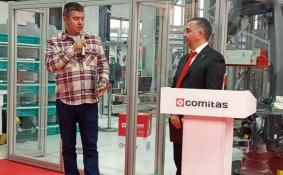Scientific & Practical Journal

Editorial News
Dear readers! We are pleased to present to you the eleventh issue of the journal in 2025. There are a lot of relevant and useful materials in the issue, which, hopefully, will not be ignored.
Dear readers! In September the CeMAT RUSSIA exhibition was held, which showed everyone that innovations and robotics are increasingly penetrating the logistics industry. We can safely say that many technologies are tested here, and only then they go out into the world. However, it is not only CeMAT RUSSIA that demonstrates the prevalence of the digital agenda.
Dear readers! This is the ninth issue of the journal, which turned out to be very rich and diverse. Traditionally, the issue is opened by an analyst. The material by Alina Nasyrova from the Market Guide Agency, dedicated to investments in warehouse complexes in Russia, recalls the importance of developing logistics infrastructure for the integrated development of regions.
PHOTO OF THE WEEK
CITATIONS
Editorial News
Published No. 2 of the LOGISTICS journal for 2025
Dear readers! We present to your attention the third issue of the LOGISTICS journal for 2025. Our editorial staff, like all our colleagues, is preparing for the TransRussia 2025 exhibition, the largest event in the industry. In this issue, we have prepared an interview with Natalia Lomunova, Director of TransRussia, with whom we are talking about a flexible approach, new participants and digital services. We continue the series of articles from P.V. Kurenkov and co-authors on the logistics of the Eastern landfill. This time, the material is devoted to the main directions of the implementation of the third stage of modernization of Russian railways and proposals aimed at optimizing transport processes. You will be interested in the article by G.G. Chichin, I.P. Elyashevich, E.I. Makarov on the introduction of intelligent technologies for monitoring operational resource stocks in warehouses of logistics companies through the prism of their perception by various groups of employees. The topic of digital technologies is continued by A.V. Tsevelev and V.V. Tsevelev. The authors discuss the use of AI capabilities on railways, which is crucial for unlocking the potential of predictive analytics. I.N. Egorova, I.A. Solop, E.A. Chebotareva consider the development of a system of transport and logistics infrastructure for low-mobility groups of the population using the example of railway station complexes in the south of Russia. The article places important emphasis on improving the quality of transport services for this population group and suggests measures to improve their service.
Dear friends, we remind you that the editorial staff of the magazine is always open for cooperation and new topics. We are waiting for your suggestions at the following addresses: editor@mg-agency.com, comers@mg-agency.com












